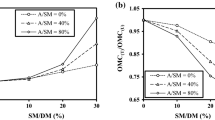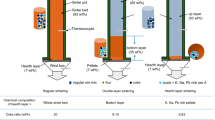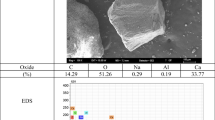Abstract
Geopolymer bricks from lead glass sludge (LGS) and alumina flakes filling (AFF) waste were synthesized in the present work. AFF waste was chemically treated to prepare sodium aluminate (NaAlO2) powder. Silicate source (untreated LGS and thermally treated one at 600 °C (LGS600)) and sodium oxide (Na2O) concentration (as NaAlO2) were the compositional parameters, which affected the physical and mechanical properties (compressive strength, water absorption, and bulk density) of the prepared bricks. High organic matter content inside LGS caused a retardation effect on the geopolymerization process, resulting in the formation of hardened bricks with modest 90-day compressive strengths (2.13 to 4.4 MPa). Using LGS600 enhanced the mechanical properties of the fabricated bricks, achieving a maximum 90-day compressive strength of 22.35 MPa at 3 wt.% Na2O. Sodium aluminosilicate hydrate was the main activation product inside all samples, as confirmed by X-ray diffraction and thermal analyses. Acetic acid leaching test also proved that all LGS600-NaAlO2 mixtures represented Pb concentrations in leachates lower than the permissible level of characteristic leaching procedures, indicating the mitigation of environmental problems caused by these wastes.











Similar content being viewed by others
Data availability
All data and materials will be available upon request.
References
Abdel-Gawwad HA, Mohamed SA, Mohammed MS (2019) Recycling of slag and lead-bearing sludge in the cleaner production of alkali activated cement with high performance and microbial resistivity. J Clean Prod 220:568–580
Abdel-Gawwad HA, Mohammed MS, Heikal M (2020a) Ultra-lightweight porous materials fabrication and hazardous lead-stabilization through alkali-activation/sintering of different industrial solid wastes. J Clean Prod 244:118742
Abdel-Gawwad HA, Sanad SA, Mohammed MS (2020b) A clean approach through sustainable utilization of cement kiln dust, hazardous lead-bearing, and sewage sludges in the production of lightweight bricks. J Clean Prod 273:123129
Abdel-Gawwad HA, Mohammed MS, Ads EN (2020c) A novel eco-sustainable approach for the cleaner production of ready-mix alkali activated cement using industrial solid wastes and organic-based activator powder. J Clean Prod 256:120705
Abdel-Gawwad HA (2021) Thermo-alkali activation of talc for the production of a novel white one-part alkali-activated magnesia-based cement. Constr Build Mater 306:124909
Abdel-Gawwad HA, Abd El-Aleem S, Zayed A (2021) Stabilization of hazardous lead glass sludge using reactive magnesia via the fabrication of lightweight building bricks. J Hazard Mater 403:124017
Abdel-Gawwad HA, Mohammed MS, Arif MA et al (2022) Reuse of lead glass sludge in the fabrication of thermally insulating foamed glass with outstanding properties and high Pb-stabilization. Environ Sci Pollut Res 29:47209–47224
Abdelrahman EA, Alharbi A, Subaihi A, Hameed AM, Almutairi MA, Algethami FK, Youssef HM (2020) Facile fabrication of novel analcime/sodium aluminum silicate hydrate and zeolite Y/faujasite mesoporous nanocomposites for efficient removal of Cu (II) and Pb (II) ions from aqueous media. J Mater Res Technol 9(4):7900–7914
Abolhasani A, Samali B, Aslani F (2022) Rice husk ash incorporation in calcium aluminate cement concrete: life cycle assessment, hydration and strength development. Sustainability 14(2):1012
Ahmed MM, El-Naggar KAM, Tarek D et al (2021) Fabrication of thermal insulation geopolymer bricks using ferrosilicon slag and alumina waste. Case Stud Cons Mater 15:00737
Ahmad M, Rashid K, Hameed R, et al. (2022) Physico-mechanical performance of fly ash based geopolymer brick: influence of pressure− temperature− time. Journal of Building Engineering 104161
Akinshipe O, Kornelius G (2018) Quantification of atmospheric emissions and energy metrics from simulated clamp kiln technology in the clay brick industry. Environ Pollut 236:580–590
Akinshipe O (2013) The development of an “emission Inventory Tool” for brick making clamp kilns. M.Sc. thesis. University of Pretoria
Arslan C, Gencel O, Borazan I, Sutcu M et al (2021) Effect of waste-based micro cellulose fiber as pore maker on characteristics of fired clay bricks. Constr Build Mater 300:124298
ASTM C134 – 95 (2016) Standard test methods for size, dimensional measurements, and bulk density of refractory brick and insulating firebrick. https://www.astm.org/Standards/C134.htm
ASTM C20 – 00 (2015) Standard test methods for apparent porosity, water absorption, apparent specific gravity, and bulk density of burned refractory brick and shapes by boiling water. https://www.astm.org/Standards/C20.htm
ASTM C62 (2017) Standard specification for building brick (solid masonry units made from clay or shale).
ASTM C67 / C67M – 19 (2019) Standard test methods for sampling and testing brick and structural clay tile. https://www.astm.org/Standards/C67.htm
Chavez RH (2021) Energy analysis of two coupled brick kilns: an experimental study. Clean Techn Environ Policy 23(8):2235–2249
Chen K, Lin WT, Liu W (2021) Effect of NaOH concentration on properties and microstructure of a novel reactive ultra-fine fly ash geopolymer. Adv Powder Technol 32(8):2929–2939
Chindaprasirt P, Rattanasak U (2018) Fire-resistant geopolymer bricks synthesized from high-calcium fly ash with outdoor heat exposure. Clean Techn Environ Policy 20(5):1097–1103
da Silva RT, Dias DP, França FCC et al (2018) Metakaolin-based geopolymer mortars with different alkaline activators (Na+ and K+). Constr Build Mater 178:453–461
De Silva GS, Perera BVA (2018) Effect of waste rice husk ash (RHA) on structural, thermal and acoustic properties of fired clay bricks. J Build Eng 18:252–259
dos Reis GS, Cazacliu BG, Cothenet A et al (2020) Fabrication, microstructure, and properties of fired clay bricks using construction and demolition waste sludge as the main additive. J Clean Prod 258:120733
Elkersh H (2014) Innovative cleaner production technique: foam glass production from lead crystal glass sludge. M.Sc. Thesis, School of Sciences and Engineering, the American University in Cairo, Egypt
ElKersh H, El-Haggar S (2015) Recycling of lead crystal glass sludge to produce foam glass. Int J Environ Technol Manag 18(5-6):448–464
EPA U (1992) Method 1311. Toxicity characteristic leaching procedure. US Environmental Protection Agency Washington, DC, USA
Goergens J, Manninger T, Goetz-Neunhoeffer F (2020) In-situ XRD study of the temperature-dependent early hydration of calcium aluminate cement in a mix with calcite. Cem Concr Res 136:106160
Gong B, Deng Y, Yang Y et al (2017) Effects of microwave-assisted thermal treatment on the fate of heavy metals in municipal solid waste incineration fly ash. Energy Fuel 31(11):12446–12454
Gorla G, Civati F, Maurich C et al (2022) New strategies to quantify aluminum hydroxide in powder coatings by thermogravimetric analysis and ATR-FT-MIR spectroscopy coupled with chemometrics. Microchem J 172:107005
Hashemi A, Cruickshank H (2015) Embodied energy of fired bricks: the case of Uganda and Tanzania. In: 14th International Conference on Sustainable Energy Technologies (Nottingham, England)
Hasnaoui A, Ghorbel E, Wardeh G (2021) Effect of curing conditions on the performance of geopolymer concrete based on granulated blast furnace slag and metakaolin. J Mater Civ Eng 33(3):04020501
Hodhod OA, Alharthy SE, Bakr SM (2020) Physical and mechanical properties for metakaolin geopolymer bricks. Constr Build Mater 265:120217
Irigoyen-Arredondo MS, Moreno-Sánchez XG, Escobar-Sánchez O, et al. (2022) Essential (Cu, Zn) and nonessential (Pb, Cd) metals in the muscle of leopard groupers (Mycteroperca rosacea) from a mining port in the Gulf of California, Mexico: human health risk assessment. Environ Sci Pollut Res 1-11
Jannat N, Al-Mufti RL, Hussien A et al (2022) Influences of agro-wastes on the physico-mechanical and durability properties of unfired clay blocks. Constr Build Mater 318:126011
Jin F, Gu K, Al-Tabbaa A (2014) Strength and drying shrinkage of reactive MgO modified alkali-activated slag paste. Constr Build Mater 51:395–404
Jonbi J, Fulazzaky MA (2020) Modeling the water absorption and compressive strength of geopolymer paving block: an empirical approach. Measurement 158:107695
Kadir AA, Mohajerani A (2015) Effect of heating rate on gas emissions and properties of fired clay bricks and fired clay bricks incorporated with cigarette butts. Appl Clay Sci 104:269–276
Kumbhar S, Kulkarni N, Rao A, Rao B (2014) Environmental life cycle assessment of traditional bricks in Western Maharashtra. Energy Procedia 54:260–269
Li J, Hashimoto Y, Riya S, Terada A et al (2019) Removal and immobilization of heavy metals in contaminated soils by chlorination and thermal treatment on an industrial-scale. Chem Eng J 359:385–392
Li J, Li J, Wei H et al (2021) Alkaline-thermal activated electrolytic manganese residue-based geopolymers for efficient immobilization of heavy metals. Constr Build Mater 298:123853
Linda BN, Aboubakar MA, Hounkpè BJ et al (2021) The effect of polymer waste addition on the compressive strength and water absorption of geopolymer ceramics. Appl Sci 11(8):3540
Marrocchino E, Zanelli C, Guarini G, Dondi M (2021) Recycling mining and construction wastes as temper in clay bricks. Appl Clay Sci 209:106152
Nath SK, Kumar S (2019) Role of alkali concentration on reaction kinetics of fly ash geopolymerization. J Non-Cryst Solids 505:241–251
Pacewska B, Nowacka M, Aleknevičius M et al (2013) Early hydration of calcium aluminate cement blended with spent FCC catalyst at two temperatures. Procedia Eng 57:844–850
Provis JL, Van Deventer JSJ (eds) (2009) Geopolymers: structures, processing, properties and industrial applications. Elsevier
Ramadan M, Amin MS, Waly SA, Mohsen A (2021) Effect of high gamma radiation dosage and elevated temperature on the mechanical performance of sustainable alkali-activated composite as a cleaner product. Cem Concr Compos 121:104087
Rovnaník P (2010) Effect of curing temperature on the development of hard structure of metakaolin-based geopolymer. Constr Build Mater 24(7):1176–1183
Saif MS, El-Hariri MO, Sarie-Eldin AI, et al. (2022) Impact of Ca+ content and curing condition on durability performance of metakaolin-based geopolymer mortars. Case Stud Constr Mater :e00922
Sajan P, Jiang T, Lau C et al (2021) Combined effect of curing temperature, curing period and alkaline concentration on the mechanical properties of fly ash-based geopolymer. Clean Mater 1:100002
Shen G, Xue M, Wei S et al (2013) Influence of fuel mass load, oxygen supply and burning rate on emission factor and size distribution of carbonaceous particulate matter from indoor corn straw burning. J Environ Sci 25(3):511–519
Sutcu M, Erdogmus E, Gencel O, Gholampour A et al (2019) Recycling of bottom ash and fly ash wastes in eco-friendly clay brick production. J Clean Prod 233:753–764
Taha Y, Benzaazoua M, Hakkou R et al (2016) Natural clay substitution by calamine processing wastes to manufacture fired bricks. J Clean Prod 135:847–858
Temuujin J, van Riessen A, MacKenzie KJD (2010) Preparation and characterisation of fly ash based geopolymer mortars. Constr Build Mater 24(10):1906–1910
Tuyan M, Andiç-Çakir Ö, Ramyar K (2018) Effect of alkali activator concentration and curing condition on strength and microstructure of waste clay brick powder-based geopolymer. Compos Part B 135:242–252
Van der Kuijp TJ, Huang L, Cherry CR (2013) Health hazards of China’s lead-acid battery industry: a review of its market drivers, production processes, and health impacts. Environ Health 12(1):1–10
Yaseen N, Irfan-ul-Hassan M, Saeed AUR et al (2022) Sustainable development and performance assessment of clay-based geopolymer bricks incorporating fly ash and sugarcane bagasse ash. J Mater Civ Eng 34(4):04022036
Youssef N, Rabenantoandro AZ, Dakhli Z et al (2019) Reuse of waste bricks: a new generation of geopolymer bricks. SN Appl Sci 1(10):1–10
Zainal FF, Hussin FWM, Nordin MNA, et al. (2022) The effect of curing temperature on the properties of kaolin geopolymer paste. In Journal of Physics: Conference Series (Vol. 2169, No. 1, p. 012029). IOP Publishing
Zeyad AM, Magbool HM, Tayeh BA et al (2022) Production of geopolymer concrete by utilizing volcanic pumice dust. Case Stud Cons Mater 16:00802
Zhang L (2013) Production of bricks from waste materials–a review. Constr Build Mater 47:643–655
Zhang B, Yuan P, Guo H et al (2021) Effect of curing conditions on the microstructure and mechanical performance of geopolymers derived from nanosized tubular halloysite. Constr Build Mater 268:121186
Acknowledgements
The authors extend their appreciation to Researchers Supporting Project number (RSP2022R433), King Saud University, Riyadh, Saudi Arabia.
Funding
This work is funded by Researchers Supporting Project number (RSP-2021/343), King Saud University, Riyadh, Saudi Arabia.
Author information
Authors and Affiliations
Contributions
Hamdy A. Abdel-Gawwad: conceptualization—original draft; writing—review and editing; methodology; investigation
Salah Kassem: methodology; formal analysis; investigation
Aref A. Abadel: data curation; funding acquisition; investigation
Moncef L. Nehdi: data curation; funding acquisition; investigation
Hamada Shoukry: methodology; investigation; data curation
Corresponding author
Ethics declarations
Ethics approval
Not applicable
Consent to participate
Not applicable
Consent to publish
All authors agree about submission to the journal.
Competing interests
The authors declare no competing interests.
Additional information
Responsible Editor: Philippe Garrigues
Publisher’s note
Springer Nature remains neutral with regard to jurisdictional claims in published maps and institutional affiliations.
Rights and permissions
Springer Nature or its licensor holds exclusive rights to this article under a publishing agreement with the author(s) or other rightsholder(s); author self-archiving of the accepted manuscript version of this article is solely governed by the terms of such publishing agreement and applicable law.
About this article
Cite this article
Abdel-Gawwad, H.A., Kassem, S., Abadel, A. et al. Valorizing hazardous lead glass sludge and alumina flakes filling waste for the synthesis of geopolymer building bricks. Environ Sci Pollut Res 30, 5267–5279 (2023). https://doi.org/10.1007/s11356-022-22562-3
Received:
Accepted:
Published:
Issue Date:
DOI: https://doi.org/10.1007/s11356-022-22562-3




